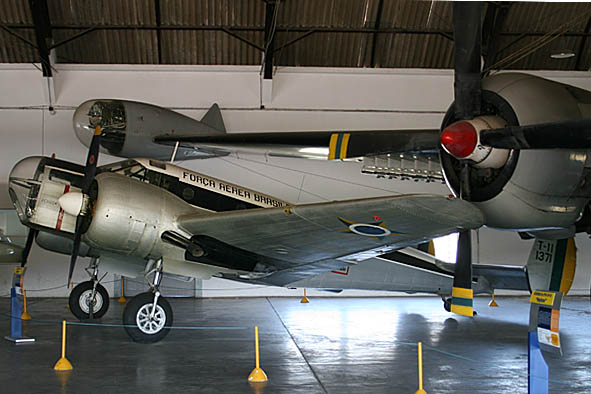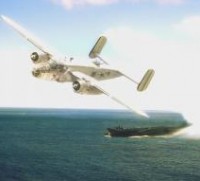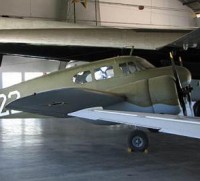BRAZILIAN AIR FORCE FAB * - BRAZILIAN AIR FORCE
2)BEECH AT 7 / AT 11 / C 45
During World War II, Brazil came to have a strategic position both in the supply of raw materials of prime importance for the allied war effort, and in the establishment of strategic points for assembling air bases and operating ports in the northeast region, this being It was because this region represented the closest point between the American and African continents for air travel, so the Brazilian coast would be fundamental in the sending of troops, vehicles, supplies and aircraft for use in the European theater. The threat posed by the action of German and Italian submarines along the Brazilian coast began to be faced after the declaration of war on the Axis countries in August and 1942, when the US Navy began to operate anti-submarine squadrons from bases mainly on the coast of northeast, in this period the newly created Brazilian Air Force did not have adequate training or air resources to carry out these missions.
With the signing of the Lean & Lease Act agreement. The terms guaranteed by this agreement would create an initial line of credit to the country in the order of one hundred million dollars, for the acquisition of war material, providing the country with access to modern weapons, aircraft, armored vehicles and tanks. These materials and equipment would be vital for the country to be able to face the Axis threats that were presented in the South Atlantic and in the future Brazilian battlefront in the fields of Italy. The exchange plan between the Brazilian Air Force and the United States Army Air Corps (USAAC) also provided for the structuring of material and doctrinal means for the training of pilots, navigators and bombers.
In February 1945 another five AT-7s were received in Rio de Janeiro and were promptly sent to the Aeronautical School (EAer) based in Campo dos Afonsos, starting to perform the work for which they were originally designed. New accidents were recorded in the following months, leading to the loss of 3 aircraft, so the Brazilian Air Force decided to acquire more aircraft in order to increase efforts in training tasks. Thus, a contract was signed with the manufacturer for the supply of ten aircraft of the Beechcraft D-18S model that, in response to Brazilian demand, incorporated many of the known characteristics of the AT-7 models. In January 1947 the aircraft were transferred to Brazil, with half being distributed to the 2nd GT and half to the Aeronautical School (EAer).
In 1946, the Brazilian Navy acquired a copy of the Beechcraft D-18S for the execution of aerial photography services for the production of nautical charts. 45F "FAB 2830" being manned by aeronautical officers, starting to carry out missions exclusively in favor of the Navy. The C-45s would still be used in VIP transport missions, initially some Beechcraft AT-7s were temporarily modified to the Beechcraft T-7 version, which was nothing more than a conversion for the transport authorities with the installation of four more comfortable seats. than the usual three seats. One of the VT-7 operating units was the Belém Air Base, which operated one of this aircraft for the benefit of the 1st Air Zone HQ. The Special Transport Group (GTE) also operated the custom version Beechcraft VC-45 for transport of authorities in addition to larger aircraft such as the Douglas VC-47 with the 2nd Squadron of the Special Transport Group, initially based in Rio de Janeiro. and after 1967 in the new federal capital Brasília.
Total received: 23
Specifications (AT-11)
Engines: Two 450-hp Pratt & Whitney R-985-AN-1 Wasp Junior radial piston engines.
Weight: Empty 6,175 lbs., Max Takeoff 8,727 lbs.
Wing Span: 47ft. 8in.
Length: 34ft. 3in.
Height: 9ft. 8in.
Performance:
Maximum Speed: 215 mph
Ceiling: 21,400 ft.
Range: 850 miles.
Armament: Two .30-caliber machine guns, one in nose, one in dorsal turret.


Above, Beech AT- 7 seen at MUSAL Museu Aeroespacial at Afonsos Airfield Rio de Janeiro



